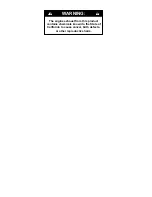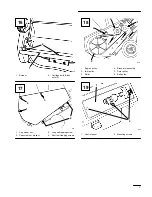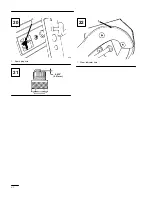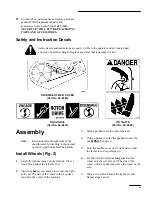
2
WARNING signals a hazard that may cause serious
injury or death if the recommended precautions are
not followed.
CAUTION signals a hazard that may cause minor or
moderate injury if the recommended precautions are
not followed.
Two other words are also used to highlight
information. “Important” calls attention to special
mechanical information and “Note” emphasizes
general information worthy of special attention.
The left and right side of the machine is determined
by standing behind the handle in the normal
operator’s position.
Safety
To ensure maximum safety, best performance, and
to gain knowledge of the product, it is essential
that you or any other operator of the snowthrower
read and understand the contents of this manual
before the motor is ever started. Pay particular
attention to the safety alert symbol
which
means CAUTION, WARNING OR DANGER —
“personal safety instruction.” Read and
understand the instruction because it has to do
with safety. Failure to comply with instruction
may result in personal injury.
This snowthrower is designed and tested to offer safe
and effective service, provided it is operated in strict
accordance with the following Safety Instructions.
Failure to comply with the following instructions
MAY RESULT IN PERSONAL INJURY.
Before Operating
1.
Read and understand the contents of this manual
before operating the snowthrower. Become
familiar with all controls and know how to stop
engine and snowthrower quickly.
2.
Never allow children to operate the
snowthrower. Adults should operate the
snowthrower only after reading this manual.
3.
Keep everyone, especially children and pets,
away from snowthrower and area of operation.
4.
Inspect area thoroughly where snowthrower will
be used. Remove doormats, sleds, boards, sticks,
wire and any other foreign objects which might
be picked up and thrown by the snowthrower.
5.
Keep all shields and safety devices in place. If a
shield, safety device or decal is illegible,
damaged or lost, repair or replace it before
beginning operation. Also, tighten any loose
nuts, bolts or screws.
6.
Wear adequate winter clothing and rubber boots
that will ensure proper footing on slippery
surfaces. Do not wear loose–fitting clothing that
could possibly get caught in moving parts.
7.
Always wear safety glasses or eye shields during
operation or while performing an adjustment or
repair to protect eyes from foreign objects that
may be thrown from the machine.
8.
Fill fuel tank with gasoline before starting the
engine. Avoid spilling any gasoline. Because
fuel is highly flammable, handle it carefully. DO
NOT SMOKE WHILE HANDLING
GASOLINE.
A.
Use an approved gasoline container.
B.
Fill fuel tank outdoors, not indoors.
NEVER ADD FUEL TO AN ENGINE
THAT IS RUNNING OR HOT. Engine
must be cool to reduce potential fire hazard.
C.
Open doors if engine will be started in the
garage because exhaust fumes are
dangerous and could possibly be deadly. Do
not run engine indoors.
D.
Wipe up any spilled gasoline. Reinstall
gasoline container cap and snowthrower
fuel tank cap securely before starting the
engine.
9.
Allow engine to warm up outdoors before
operating. Do not run engine indoors.












































